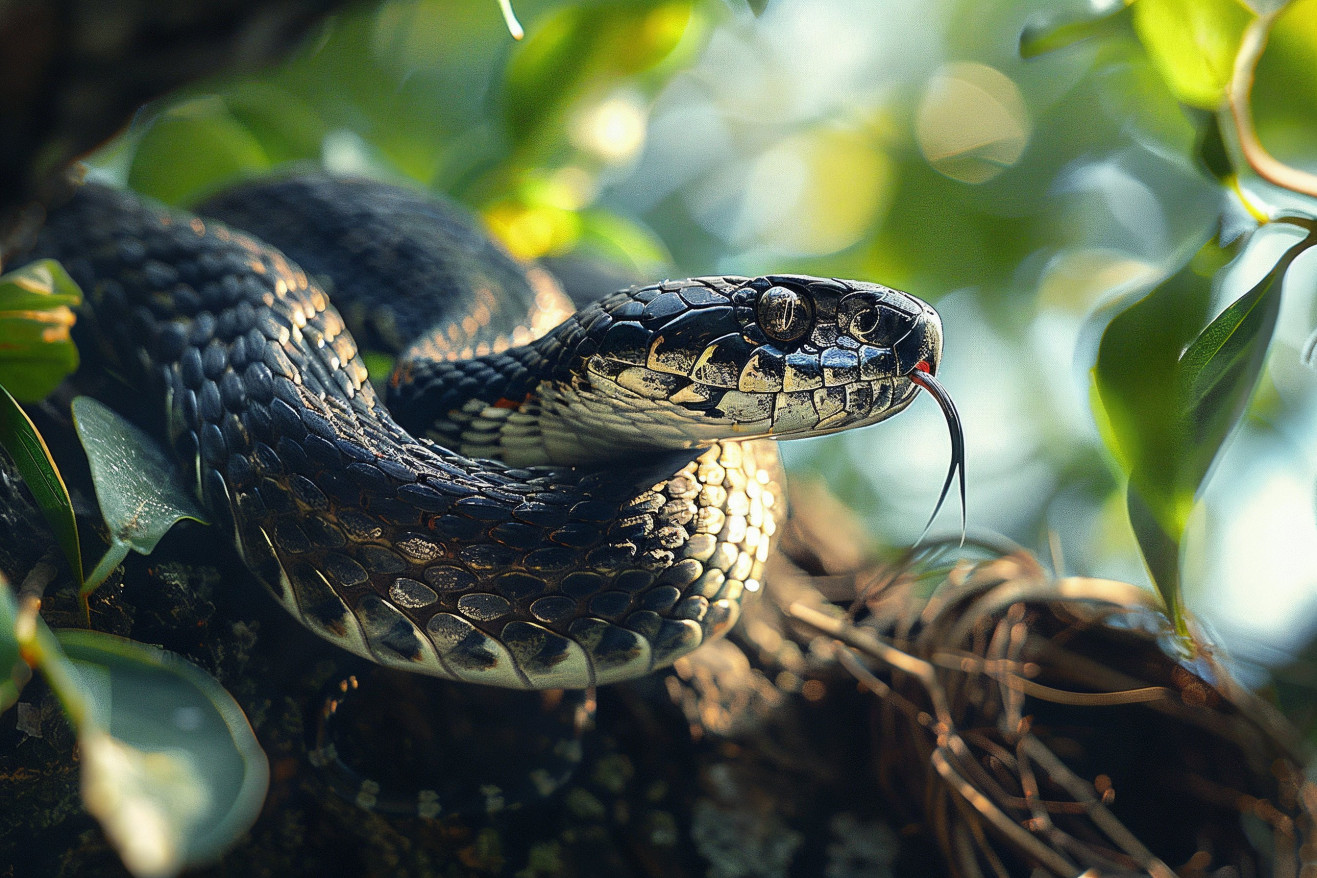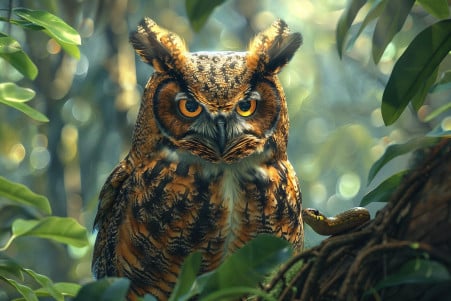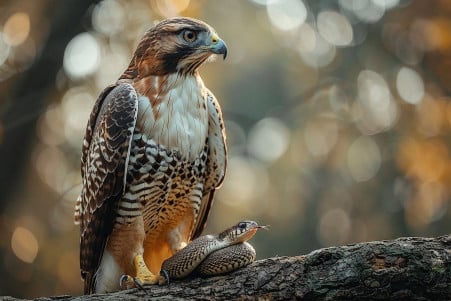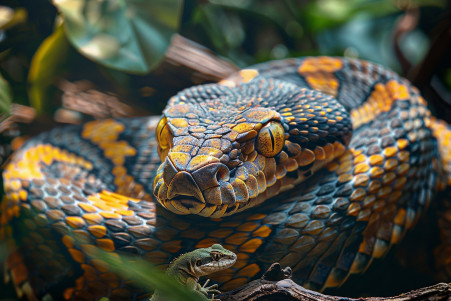Snakes Eating Birds: A Coevolutionary Arms Race
10 May 2024 • Updated 10 May 2024

Many snake species have evolved to be highly effective bird hunters, using a combination of speed, stealth, and special traits to catch and eat their avian prey. Snakes can find bird nests with their excellent sense of smell and then use their flexible jaws and the ability to dislocate their lower jaw to swallow eggs, chicks, and even adult birds whole.
This article will delve into this complex predator-prey relationship by reviewing the literature from the fields of herpetology, ornithology, and behavioral ecology. Drawing on observational, experimental, and field research, we will learn about the hunting strategies of different snakes, the ways birds have adapted to protect their nests and offspring, and the ecological consequences of snakes preying on birds. This interdisciplinary perspective will provide a rich understanding of the coevolutionary arms race between these two animal groups.
Do snakes eat birds?
How Snakes Have Adapted to Prey on Birds
Snakes have evolved a wide range of physical and behavioral adaptations that make them highly effective bird predators. For example, as one article describes, some snakes have long, slender bodies that make them highly maneuverable and able to access small spaces like bird nests, while others have short, thick bodies that enable them to strike quickly. Camouflage is a common adaptation among ambush predators, with some snakes even using "chemical crypsis" to mask their scent. Pit vipers and pythons have heat-sensing pits that enable them to detect the body heat of warm-blooded prey.
Snakes also use different hunting strategies, with some relying on ambush predation and chemical cues to find prey, and others actively hunting and using bird distress calls to track down prey. Venomous snakes use their hollow fangs to inject potent venom into birds, quickly disabling them. Constrictors use their powerful muscles to coil around their prey and immobilize it. As another article explains, some snakes use a combination of constriction and venom to maximize their hunting success.
Some snake species are especially well-adapted to raid bird nests. For example, egg-eating snakes like the African egg-eater have hinged jaws that enable them to swallow eggs whole, and arboreal snakes like cat snakes are able to climb trees to access bird nests. However, studies have found that snakes are limited by their body size, with larger snakes able to eat larger but fewer eggs, and terrestrial snakes less able to access arboreal nests. Still, the wide range of snake predation strategies makes them a major threat to bird species around the world.
How Birds Defend Against Snakes
Birds have developed a number of ways to defend their nests and offspring from snake predation. According to a study in the journal Animals, these defenses can include aggressive nest defense, distraction displays, and mobbing of snakes. Birds also choose nest sites that are less likely to be found by snakes and are harder for snakes to access.
In addition to the information from Discover Wildlife that birds have evolved alarm calls, camouflaged eggs, and nest sanitation to protect their offspring from snake predation, the effectiveness of these adaptations can depend on the type of habitat and the predator species, as a study in the journal Animals found.
While these defenses help birds protect their nests, they also have costs and trade-offs. For example, aggressive nest defense can increase the risk of injury or predation for the parents. According to the Searchable Ornithological Research Archive, a bird's alarm calls can even help snakes find their nests. This highlights the importance of understanding the relationships between birds and their snake predators to inform conservation efforts.
Snakes and the Environment: The Impact of Snake Predation on Bird Populations
Snakes are some of the most important nest predators and are responsible for a large portion of bird nest failures. For example, in the Midwestern United States, a study found that the presence of rat snakes was the only factor that significantly increased the risk of predation for songbird nests. This predation can have a negative impact on the reproductive success and population dynamics of at-risk bird species.
The impact of snake predation is often worse in habitats that have been broken up into smaller sections. For example, in China's Yancheng Nature Reserve, a study found that snakes were the main predator of the endangered reed parrotbill, but the survival rate of artificial nests was much higher than that of natural nests. This indicates that habitat fragmentation and edge effects are causing an increase in snake activity and nest predation.
In fact, the Audubon article even points out that the Eastern indigo snake is an apex predator that helps control the populations of other snakes that are predators of birds. The loss of this snake from much of its original range in the southeastern United States is likely one of the reasons that bird populations have declined. Bringing the Eastern indigo snake back to its original range could help restore the balance in these ecosystems.
Dealing with the environmental impact of snake predation on at-risk bird species will be an important part of conservation efforts in the future.
Conservation Efforts to Reduce Snake Predation
Protecting birds from snake predation will likely require a combination of different conservation efforts. As the NestWatch article explains, one of the most successful methods is to use physical barriers to keep snakes away from nesting sites. In a study in Spain, a basic acetate sheet placed around the base of trees with nest boxes was extremely effective, reducing predation from 20% to 2%.
The article also emphasizes the importance of designing nest boxes that are snake-proof. This can be done by making sure the boxes have smooth, slippery surfaces and small openings that snakes can't fit through. Conservation Evidence explains that the use of barriers and cages around individual nests or entire nesting sites is a common way to protect against predators.
In addition to physical barriers, habitat management can also help reduce snake predation. As the Audubon article explains, reintroducing apex predators like the Eastern indigo snake can help keep the populations of other snake species that prey on birds in check. Restoring the natural balance of these ecosystems could be an important conservation goal.
In the end, a mix of targeted conservation efforts, habitat restoration, and predator control will be needed to save bird species from the threat of snake predation. However, by looking at examples of what has worked and what hasn't, we can hopefully find a way for these two groups to live in harmony.
Cultural and Symbolic Significance of Snakes Eating Birds
The relationship between snakes and birds has long been a part of the mythologies and belief systems of cultures throughout the world. According to Ancient Origins, the snake and the bird have been connected to the dualities of life and death, with the bird as the "spirit of life" and the serpent as the "sting of death."
This duality is evident in the many depictions of snakes and birds in ancient religious and mythological art. As Wikipedia notes, snakes have been worshipped as symbols of fertility, wisdom, and protectors of sacred spaces in a wide range of cultures. Meanwhile, birds have often been shown as symbols of liberty, transcendence, and divine messengers, with their ability to fly high in the sky representing humanity's desire to rise above the material world.
The relationship between snakes and birds as predator and prey has also been a common theme in creation myths and spiritual beliefs. As The Aswang Project points out, the serpent is often the guardian of the cosmic center or the tree of life, while the bird is the messenger that travels between the heavens and the earth. The conflict between these two archetypes in myths like the Bikolano story of the goddess Haliya's battle with the serpent Bakunawa demonstrates how deeply this relationship has been embedded in cultural beliefs.
In the end, the relationship between snakes and birds has continued to fascinate and inspire people of all faiths, providing a diverse array of cultural and spiritual beliefs about the complex relationship between these two amazing animals.
Conclusion: The Ongoing Evolutionary Arms Race
Snakes are highly effective predators that have evolved a wide range of adaptations that enable them to successfully hunt and eat birds. From their specialized skulls and heat-sensitive facial pits to their varied hunting techniques, snakes are a major threat to bird populations, especially when it comes to nest predation.
Yet, birds have not taken this threat lying down. They have evolved a wide range of anti-predator behaviors, from aggressive nest defense to selective nest site choice, to protect their offspring. This ongoing evolutionary arms race between snakes and birds is a powerful example of the complexity and ever-changing nature of predator-prey relationships.
This relationship needs to be understood and managed, as snake predation can have serious ecological consequences, including the endangerment of already at-risk bird species. Conservation measures, including the use of physical barriers, predator-proof nest boxes, and habitat management, can be used to reduce the impact of snake predation. In addition, reintroducing apex predators like the Eastern indigo snake can help restore the natural balance of these ecosystems.
In the end, the intricate and ever-changing relationship between snakes and birds is a microcosm of the larger web of life on Earth. As we learn more about the details of this predator-prey relationship, we also learn more about how to protect and preserve the fragile balance of our natural world.


